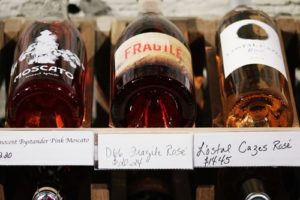Rosé wine is one of the world’s most popular wines and actually one of the oldest, something many people are unaware of. Despite this, there are some myths and misconceptions about rosé that we hear quite a lot at Octavian.
We have therefore put this handy guide together, detailing rosé wine’s origin and how it is made. In the latest instalment of our ever-popular blog, we look at exactly what makes a rosé a rosé or pink wine and how there are particular production techniques that make it genuine.

How Is a Rosé Made?
It is a common myth that rosé is made by mixing red and white grapes together during production. Whilst close to the truth in some instances, this is just not true. Rosé takes its colour from the fact that grape skins are left on during the early stages of manufacture, meaning it is close to being classed as a red wine but not quite.
Due to the process of the skins being left on the grapes, rosé is actually regarded to be one of the oldest types of wine known to man as it is a lot simpler a task than making a crisp white or rich red wine. This is also why there are many different shades of rosé wine ranging from the onion skin shade all the way up to the near purple rosés you can find in the USA and hotter parts of Europe.
There are actually three different methods one can choose when making a rosé wine. These are:
Skin Contact
This is the aforementioned method and is chosen when rosé is the primary product. Black skinned grapes are used and duly crushed, the skins are left to ferment with the rest of the fruit albeit for a short period of time. This is usually between 2 to 20 hours before they are pressed and the skins are discarded. When making red wine, these skins would be left on throughout the entire process which is the big difference between the two types of wine.
Saignée
Derived from the French term for bleeding, saignée is a process used by winemakers when looking to impart more tannins. Some of the pinker juice can effectively be removed from the process at an earlier stage and this gives a more intense colour and flavour and is often used by some of the more reputable rosé producers. It provides are more concentrated product and this often results in a richer, more authentic taste. One will usually end up with a lovely rich red must and the pink juices that have been extracted will be used to create many of the rosé wines you drink today.
Blending
This is the least popular method and one that is actually illegal in many of the classic wine producing regions, particularly in France. This is the process we mentioned at the start of this guide whereby mixing red wine and white wine creates a hybrid product. It is uncommon, discouraged and forbidden, which is why we are so keen to distance ourselves from it here at Octavian. It is possible, but not something we would ever recommend to our readers.
The Origin of Rosé
Determining when the very first bottle of pink wine labelled rosé was produced and consumed is virtually impossible, for obvious reasons. However, as we have touched on briefly, it is highly likely that the very first red wines were more like rosé in colour and texture due to the techniques used. It is doubtful that the technology existed to effectively saignée so the result would have been what is a rose wine today – albeit less pleasant.
Like most wines, the origins of rosé are likely to have emanated from the ancient Greeks who colonised France back before Christ and will have taken advantage of the soil, grapes and climate in regions that are known as Marseille and Bordeaux today. However, they will have diluted this concentrated wine, as it was considered civilised to do so. Indeed, the drinking of pure wines was reserved for savages and barbarians at this time, most probably due to its taste and the fact that it will have been a lot stronger than any rosé one can buy today.
Today, the Portuguese are thought to be producing the best rosé wines and Californian Zinfandels are also very popular, particularly when drunk on a hot summer’s day. Chilled, of course. What is certainly true is that rosé is now a very respectable drink and one that can be considered to be fine when purchasing from the best in the business.
Moet & Chandon for instance, are unlikely to put their name to anything substandard, which tells you everything you need to know about the quality of rosé wines today.